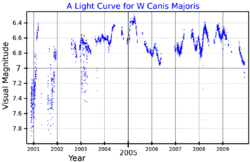Astronomy:W Canis Majoris
| Observation data Equinox J2000.0]] (ICRS) | |
|---|---|
| Constellation | Canis Major |
| Right ascension | 07h 08m 03.43652s[2] |
| Declination | −11° 55′ 23.7977″[2] |
| Apparent magnitude (V) | 6.35–7.90[3] |
| Characteristics | |
| Spectral type | C6,3(N)[3] |
| B−V color index | +2.55[4] |
| Variable type | Lb[3][5] |
| Astrometry | |
| Radial velocity (Rv) | 23.00[6] km/s |
| Proper motion (μ) | RA: −6.518[2] mas/yr Dec.: 2.280[2] mas/yr |
| Parallax (π) | 1.8049 ± 0.1454[7] mas |
| Distance | 1,800 ± 100 ly (550 ± 40 pc) |
| Details | |
| Radius | 234[8] R☉ |
| Luminosity | 3,560[8] L☉ |
| Surface gravity (log g) | 0.0[8] cgs |
| Temperature | 2,900[8] K |
| Other designations | |
| Database references | |
| SIMBAD | data |
W Canis Majoris (W CMa) is a carbon star in the constellation Canis Major. A cool star, it has a surface temperature of around 2,900 K and a radius 234 times that of the Sun, with a bolometric absolute magnitude of −4.13 and distance estimated at 443 or 445 parsecs (1,444–1,450 light-years) based on bolometric magnitude or radius. The Gaia Data Release 2 parallax of 1.8049±0.1454 milliarcseconds implies a distance of about 555 parsecs.
W CMa is classified as a slow irregular variable star. Detailed analyses have found only very weak and probably spurious periods of approximately a month.[5] It is a carbon star, an asymptotic giant branch star where carbon and s-process elements have been dredged up to the surface during thermal pulses of the helium-burning shell.[9]
References
- ↑ "ASAS All Star Catalogue". The All Sky Automated Survey. http://www.astrouw.edu.pl/asas/?page=aasc.
- ↑ 2.0 2.1 2.2 2.3 Van Leeuwen, F. (2007). "Validation of the new Hipparcos reduction". Astronomy and Astrophysics 474 (2): 653–664. doi:10.1051/0004-6361:20078357. Bibcode: 2007A&A...474..653V.
- ↑ 3.0 3.1 3.2 Samus, N. N. et al. (2009). "VizieR Online Data Catalog: General Catalogue of Variable Stars (Samus+ 2007-2013)". VizieR On-line Data Catalog: B/GCVS. Originally Published in: 2009yCat....102025S 1. Bibcode: 2009yCat....102025S.
- ↑ Alksnis, A.; Balklavs, A.; Dzervitis, U.; Eglitis, I. (1998). "Absolute magnitudes of carbon stars from HIPPARCOS parallaxes". Astronomy and Astrophysics 338: 209. Bibcode: 1998A&A...338..209A.
- ↑ 5.0 5.1 Percy, J. R.; Terziev, E. (2011). "Studies of "Irregularity" in Pulsating Red Giants. III. Many More Stars, an Overview, and Some Conclusions". The Journal of the American Association of Variable Star Observers 39 (1): 1. Bibcode: 2011JAVSO..39....1P.
- ↑ Gontcharov, G. A. (2006). "Pulkovo Compilation of Radial Velocities for 35 495 Hipparcos stars in a common system". Astronomy Letters 32 (11): 759–771. doi:10.1134/S1063773706110065. Bibcode: 2006AstL...32..759G.
- ↑ Brown, A. G. A. (August 2018). "Gaia Data Release 2: Summary of the contents and survey properties". Astronomy & Astrophysics 616: A1. doi:10.1051/0004-6361/201833051. Bibcode: 2018A&A...616A...1G. Gaia DR2 record for this source at VizieR.
- ↑ 8.0 8.1 8.2 8.3 van Belle, Gerard T.; Paladini, Claudia; Aringer, Bernhard; Hron, Josef et al. (2013). "The PTI Carbon Star Angular Size Survey: Effective Temperatures and Non-sphericity". The Astrophysical Journal 775 (1): article id. 45, 19 pp. doi:10.1088/0004-637X/775/1/45. Bibcode: 2013ApJ...775...45V.
- ↑ Herwig, Falk; Austin, Sam M. (2004). "Nuclear Reaction Rates and Carbon Star Formation". The Astrophysical Journal 613 (1): L73–L76. doi:10.1086/424872. Bibcode: 2004ApJ...613L..73H.
 |


